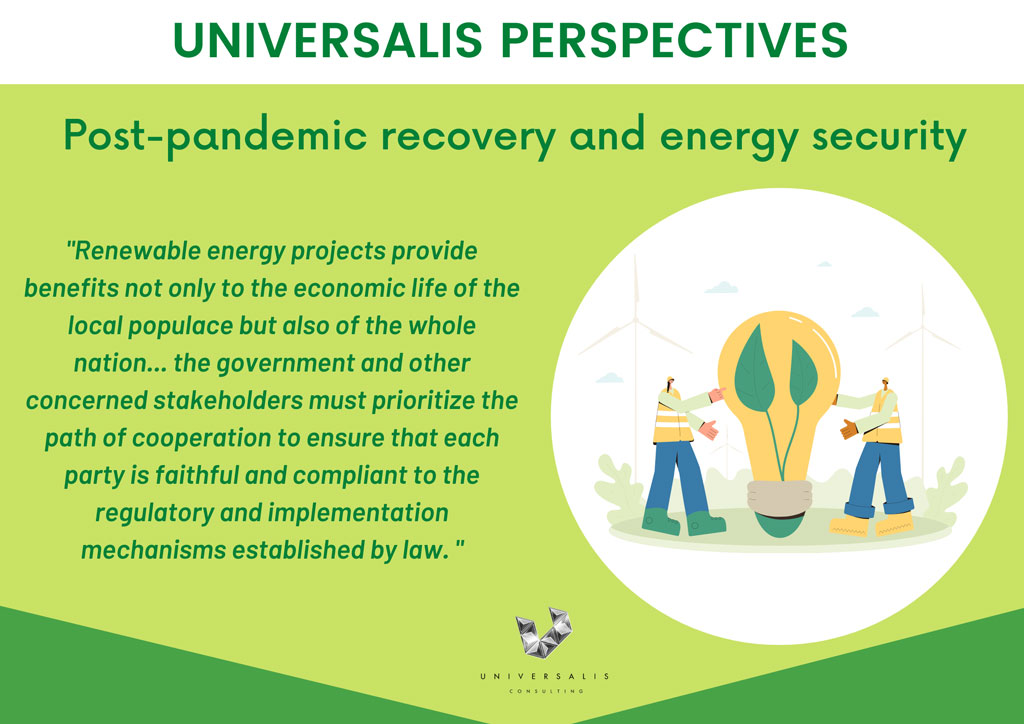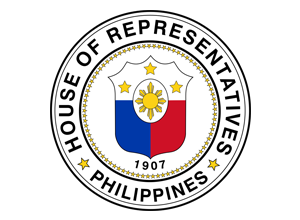Universalis Perspectives: Energy security and post-pandemic recovery

As the world continues to battle the pandemic on its second year, global economic recovery still remains as a handful task for world leaders. With the approaching stabilization of vaccine supply for the global population, states are now gearing up to open their economies and recover from the recession inflicted by this global health crisis. However, despite optimistic predictions from economists and expert fora on Philippine economic recovery, the country is still viewed as the last among ASEAN member-states to reclaim its previous economic vitality prior to the pandemic.
At present, the latest annual GDP growth remains in the negative while four million Filipinos are reported jobless and suffering from extreme hunger rates. Responding to this problem, the government is exhausting possible efforts to preserve businesses and attract more investments to create jobs for the local populace. However, while new legislations are proposed to facilitate easier entrance of investments to the country, the logistical dimension and cost of doing business in the country still serve as a hindrance for both domestic and foreign investors. Two of these obstacles are the unstable power supply and expensive electricity rates in the country.
In addition, further aggravating the problem is the antiquity of most power plants operating in the Philippines – regardless of whether they are the traditional coal plants or facilities harnessing renewable energy sources. In fact, last May and June 2021, rotational brownouts and higher electricity rates burdened households and establishments as most powerplants supplying the Luzon grid decided to temporarily shutdown their operations for maintenance and repair.
The thin electric supply brought by incapacity of already existing coal powerplants in the Philippines was complemented by a moratorium by the Department of Energy (DoE) to no longer approve new coal plant applications. Such step reflects the Philippine commitment to gradually invest and shift to renewable energy sources such as hydroelectric, geothermal, and wind-generated power. In relation, the DoE has been consistent in promoting inland water forms in the country especially rivers and waterfalls to serve as potential sites for hydroelectric powerplant (HPP) construction.
Due to the potential abundant power supply HPPs can provide, the DoE’s National Renewable Energy Program (2011-2023) targets to increase Philippine hydropower capacity by 160% at the end of the 2030. With increased confidence to the potential HPPs, it is necessary to enumerate some of its advantages compared to traditional power plants.
First, HPPs can generate more electricity compared to powerplants relying on coal and natural gas. In addition, such power can be generated quickly and can be immediately supplied to the grid.
Second, power generated by HPPs is easier to be connected to other grids compared to the infrastructure arrangements where traditional powerplants are currently located.
Third, HPPs are also possible to be integrated to other renewable energy systems such as wind turbines, geothermal, biomass, etc. While such system requires big investment, the cost-benefit analysis provides that integrating these renewable energy systems is more efficient and flexible in addressing energy needs.
Fourth, latest HPP technology is no longer dependent only to the kinetic energy from water currents. In some cases, HPPs are using water vortex technology to artificially produce strong water movement that will be harnessed for energy production.
Unfortunately, some HPP construction projects already geared for implementation are currently questioned because of alleged harmful effects to the local environment and threats to the indigenous heritage located in the proposed construction site. These include possible excessive flooding, loss of biodiversity of flora and fauna, displacement of indigenous groups, destruction of indigenous agricultural livelihood, and erasure of indigenous cultural heritage as these groups will be compelled to relocate.
While these concerns are valid and must be acknowledged, it is also important to recognize that the government has existing procedures guiding the settlement of these issues. Among them are the clearances required by government agencies specifically the Department of Natural Environment and Resources (DENR) and the National Commission on Indigenous Peoples (NCIP). It is necessary for both the government and concerned parties from the business community and civil society to cooperate in ensuring the implementation of these procedures as prescribed by law such as property compensation for affected households and communities, relocation and provision of livelihood to indigenous groups, and compliance to environmental policies during the construction stage.
It is of crucial importance to account the existence of these measures as the country struggles to recover from the negative economic effects of the pandemic. Renewable energy projects provide benefits not only to the economic life of the local populace but also of the whole nation. Demonizing these efforts is totally counterproductive and unnecessary. Instead of opposing and delaying the construction of these renewable energy facilities, the government and other concerned stakeholders must prioritize the path of cooperation to ensure that each party is faithful and compliant to the regulatory and implementation mechanisms established by law. Since the goal is to protect the economic, cultural, and environmental interests of various groups involved, isn’t this approach more productive and beneficial for the common good of every Filipino?


